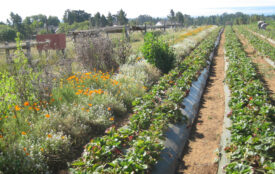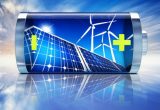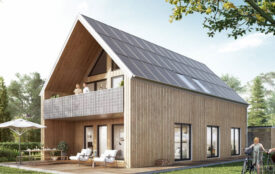Sustainable wellness with solar energy
Solar Fitness and Wellness Unit opens its doors.
There is a growing need in our society for fitness and wellness, which generally incurs environmental costs and swallows up large quantities of energy. At NEST, the Empa and Eawag research and innovation building, a global innovation will be put into operation on 24 August: a fitness and wellness facility powered entirely by solar energy and the power generated by its users’ physical exercise. The Swiss-Liechtensteinian building technology association, suissetec, made a significant contribution to the facility’s development.
The Solar Fitness and Wellness Unit’s concept has two purposes: to substantially reduce the energy consumption of wellness facilities, and to produce the remaining energy by itself. It is part of NEST, the modular research and innovation platform on the Empa campus in Dübendorf, and it is enthroned on the building’s uppermost platform. Two glass facades, each around eight meters high, are its eye-catching exterior features. But the architectural design by architect Peter Dransfeld is also spectacular on the inside: in the interior space, which is open throughout, three ellipsoids hover below the ceiling. They house two saunas and a steam bath. Under the wellness modules, a range of fitness equipment invites you to work out. Soon, this equipment will be used by the staff of both research institutes, Empa and Eawag.
At NEST, research, industry, and the public sector work together in order to test new technologies, materials, and systems in the fields of construction and energy under real-world conditions. NEST is designed as a “living lab” – which means that its flats and office spaces are actually used, while simultaneously serving as experimental environments for innovation. This means that, even in the case of Solar Fitness and Wellness, the experience of using the wellness facilities is still a means to an end: “Our objective is to be able to meet an energy-intensive need such as wellness entirely through renewable energy,” explains Peter Richner, Deputy Director of Empa and Strategic Manager of NEST.
Only the practical test will show whether the energy objectives that have been set can be achieved. And the objectives are ambitious: “We want to operate the facility with one sixth of the energy that it would need with conventional operation,” says Mark Zimmermann, Innovation Manager for NEST. More specifically: the aim is to reduce the 120,000 kWh of electricity that the Finnish sauna, the bio sauna, and the steam bath would normally swallow up each year to a figure of 20,000 kWh. This massive reduction is to be achieved by using a high-temperature CO2 heat pump (see box) from the company Scheco, which can generate temperatures of up to 130°C. For efficient operation, the generated heat must be used over as great a range of temperatures as possible. To this end, the respective heat levels required for the different wellness modules are coordinated as a cascade. The heat is stored in layers in a large tank and made available for each of the various uses: 120°C for the Finnish sauna, 90°C for the steam generator in the steam bath, 70°C for the bio sauna, and finally 50°C and 30°C for the showers and the heating, respectively. The underlying energy concept was developed jointly by Empa researchers, the NTB International University of Applied Sciences and Technology at Buchs, and Lucerne University of Applied Sciences and Arts.
Using heat efficiently and avoiding losses
Using the CO2 heat pump to generate heat reduces electricity consumption by around two thirds on its own. Moreover, additional heat and moisture recovery from the sauna and steam bath means that ventilation losses can be reduced by at least 50%. “There is also a control system that responds to actual bookings of the wellness modules and only heats them up when necessary,” explains Zimmermann. In addition, improved heat insulation ensures minimal heat losses.
In order to make optimal use of the north facade as well, it is fitted with an eight-meter-quadruple glazing from the company Glas Troesch. With an insulation value U of 0.3 W/(m2·K), in the winter semester this facade achieves a more favorable heat balance than a highly insulated wall five times thicker, while also providing a high level of comfort and daylight.
On the facade and on the roof, three photovoltaic installations provide the remaining electricity, which amounts to around 20,000 kWh on average per year, via solar generation. The bifacial glass-glass modules from the company Meyer Burger convert sunlight on both the front and rear sides into electrical energy – reflected by the roof’s material and the facade’s white cladding. In addition to the photovoltaic installations, there is also a solar thermal system for warm water. And, last but not least, the fitness facility users contribute to energy production by using fitness equipment that generates electricity. So, after working out hard in a training session, you can relax in the sauna with a clear conscience.
All the links in the value creation chain pull together
“In the Solar Fitness and Wellness Unit, representatives of every link in the value chain work together in partnership on a new sustainable solution – manufacturers of individual components, building technicians, planners, and potential customers,” says Peter Richner. Ultimately, NEST stands for and promotes precisely this kind of interdisciplinary cooperation, and the expedited innovation process that results from this.
For the building technology sector, this pioneering project is a milestone, which is why the Swiss-Liechtensteinian building technology association, suissetec, has actively supported the creation of the Solar Fitness & Wellness Unit. “NEST demands solutions that have never been asked for before. To meet this demand, you can’t afford to focus only on your little area. Everyone needs to plan together from the start. At NEST, our sector has an ideal opportunity to try out this cooperation and find out how it works,” says suissetec President Daniel Huser.









